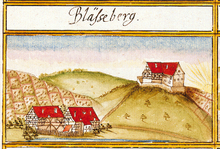Bläsiberg


The Bläsiberg fruit farm is located on a mountain slope above the Steinlachtal near Tübingen . The Bläsiberg residential areas and the nearby Bläsibad pool are both part of the Derendingen district of Tübingen .
history
According to an imaginative fairytale tradition, the history of the settlement of the Bläsiberg already took place at a very early point in time: When Emperor Titus Vespasianus besieged Jerusalem, a Count Palatine of Tübingen with the name Rabotus is said to have been among his troops and who held himself so bravely that the emperor gave him a castle on the Bläsiberg, on which the inscription: TVB (Titi Vespaniani beneficio) was attached. When a town later emerged in the nearby valley, it was given the name Tubingen, which was drawn from it. This city was completely destroyed by the predatory Huns in the fifth century and rebuilt in the place where it still stands. The count palatine favored this etymological fairy tale in order to give their sex more prestige, and still claimed in the sixteenth century that they had a certificate about it written on tree bark and a mug given by Vespasian, their ancestor. But when more detailed investigations were carried out during the Reformation and the historians wanted to see these monuments, they had already been lost.
At the end of the 11th century gave Liutold Achalm the monastery Zwiefalten one the St. Blaise chapel dedicated. In the course of time, the chaplain on the Bläsiberg fell to the Tübingen monastery . Besides the chapel there was a house, a yard and two barns.
Around 1860, the agricultural economist and professor for forestry and agriculture Heinrich von Weber leased the Bläsiberg estate for practical instruction of the students. After multiple changes of ownership, the property came to the city of Tübingen in 1951 with 40 hectares of arable and meadowland and 32 hectares of forest.
At the end of the 1950s, the Bläsiberg municipal fruit farm was established there and operated until the beginning of the 1990s. The Schell and Grüter families have been managing the estate as Obstgut Bläsiberg GbR since 1994 . At the same time, the company was converted to biodynamic cultivation, and in 1997 it received Demeter certification.
swell
- ^ H [einrich] F [erdinand] Eisenbach: Description and history of the university and city of Tübingen. CF Osiander, Tübingen 1822, 728 pages. Page 1.
- ↑ Obstgut Bläsiberg GbR ( Memento of the original from August 25, 2011 in the Internet Archive ) Info: The archive link has been inserted automatically and has not yet been checked. Please check the original and archive link according to the instructions and then remove this notice.
Coordinates: 48 ° 29 '29 " N , 9 ° 4' 14.9" E
